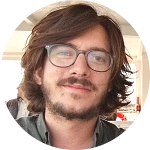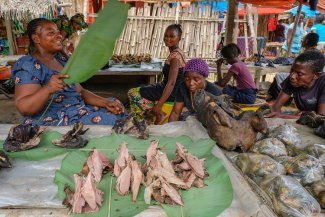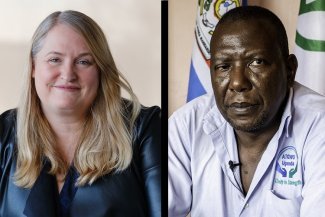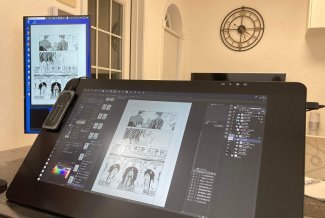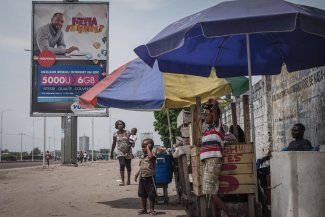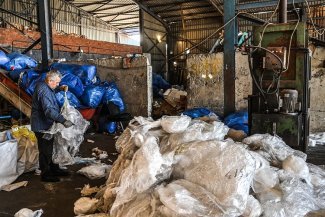According to research from the World Health Organization, around 75 per cent of new diseases that have affected humans over the last decade were caused by pathogens carried by animals. Some of these zoonotic diseases – for instance Ebola and Covid-19 – have led to major global health crises.
The Global Virome Project estimates over 1.6 million unknown viruses currently lurk in animals, of which approximately 700,000 have the potential to infect and cause diseases in humans. For Equal Times, journalists Dicta Asiimwe and Pablo Garrigós report on the work being done to track emerging infectious diseases at Bwindi Impenetrable National Park.

Tourists from Canada and the US take pictures of a gorilla at Uganda’s Bwindi Impenetrable National Park in May 2022.
International tourists pay an entrance fee of $700 (€687) to trek through Bwindi Impenetrable Forest Park, home to endangered mountain gorillas and other wildlife species. The park in south-western Uganda is one of the places that has been identified by the international scientific community as a hotspot for zoonotic ‘spillovers’, or the transmission of pathogens from wild animals to humans.
Foreign tourists come from all over the world to view the mountain gorillas, which have until now failed to survive outside of their natural habitats in Bwindi park, Mgahinga National Park in Uganda, Rwanda’s Volcanoes National Park and the Democratic Republic of Congo’s Virunga National Park.

A panoramic view of Bwindi Impenetrable National Park. Hilltops in Rwanda and the Democratic Republic of Congo, both located a few kilometres from the Ugandan national park, can be seen in the background.
In addition to the endangered mountain gorillas, the national parks in Uganda, Rwanda and DR Congo host many other species. Bwindi park has for instance been listed as a UNESCO World Heritage Site since 1994 due to its exceptional biodiversity. UNESCO notes that the park’s undulating, steep hills are home to hundreds of tree, bird and butterfly species, as well as chimpanzees, baboons, monkeys and bats.

The Gorilla Doctors team, led by chief veterinarian Bernard Ssebide, operate on a gorilla caught in a snare left by a poacher. They will also take blood, saliva and nasal samples to determine the presence of pathogens in the animal’s body.
Dr Bernard Ssebide is head veterinarian at Gorilla Doctors. The NGO’s original mission to treat mountain gorillas has expanded to working with the EpiCenter for Emerging Infectious Disease Intelligence (EEIDI) at the University of California, Davis, in the United States. As part of this collaboration, Gorilla Doctors staff now hunt for viruses and pathogens with the potential to cause the next epidemic or pandemic, and try to reduce the possibility of diseases jumping from animals to humans in Bwindi. Dr Ssebide tells Equal Times that bats and primates live and interact with a relatively high population of both tourists and locals in Bwindi, making a new outbreak “inevitable”.

A red-tail monkey jumps between buildings at Bwindi Community Hospital.
Without the right measures, Bwindi has the potential to become ground zero for the next global epidemic or pandemic, Dr Ssebide says.
The US National Institutes of Health, the largest biomedical research agency in the world, agrees with Dr Ssebide. It has identified Bwindi as one of the global hotspots for viruses and other pathogens with the potential to cause the next HIV/AIDS, Covid-19, monkeypox, Marburg, yellow fever, Ebola or Zika virus due to its rich biodiversity, the high number of international visitors and its geographic location. Bwindi park is located a few kilometres from land borders with Rwanda and the Democratic Republic of Congo, and a visitor who becomes infected with a virus at the park could spread it to other parts of the world in a short period of time.

Dilly Muhumuza from Gorilla Doctors collects saliva samples from baboons on the park’s edges.
Dr Christine Kreuder Johnson, director of the EpiCenter for Disease Dynamics and a professor of medicine and epidemiology at UC Davis, says her team’s role is to fund and determine through modelling where an emerging infectious disease might come from next. “That is the opportunity for us to do predictable modelling about what time of year and what sort of regions or areas will potentially put people at risk,” Dr Johnson says.

A specimen of Aedes Aegypti is analysed by Jelica J Joyner, team leader of EEIDI’s mosquito programme. This type of mosquito can carry zoonotic diseases like the dengue virus, yellow fever virus, Chikungunya virus and Zika virus.
Dr Ssebide’s team includes three Ugandan veterinarians – Nelson Bukamba, Dilly Muhumuza and Ricky Okwir – and one US researcher, Jelica J Joyner, who supervises the EEIDI research centre’s mosquito programme. The team regularly collects samples from bats, primates and insects at Bwindi park. After preliminary testing, the samples are sent to the Uganda Virus Research Institute, where they are tested for viruses with the potential to affect humans, says John Kayiwa, a laboratory manager at the institute.
The local research institute also analyses samples from patients at Bwindi Community Hospital, which is run by an American NGO. Patients with a rash, haemorrhagic disorders, or fevers above 38 degrees Celsius who live near Bwindi park are tested for infectious diseases as part of the EEIDI project.
If an infectious disease with the capacity to affect humans is found in the tested human or animal samples, Uganda’s ministry of health is alerted, which then works with locals to trace the contacts of the infected persons.
“It is about knowing what infectious diseases exist where, how [they] can move from there to people and what can be done to mitigate that pathway. Or, if the disease has moved from humans to animals, can it be detected early enough?” says Ssebide. The WHO says that diseases that jump from animals to humans are on the rise. According to the WHO, the best way to stem the increase in such zoonotic diseases in Africa is to use the ‘one health approach’, which sees doctors, veterinarians and local communities coming together to address the healthcare needs of humans and animals. “Zoonotic diseases are caused by spillover events from animals to humans. Only when we break down the walls between disciplines can we tackle all aspects of the response,” says Matshidiso Moeti, WHO regional director for Africa.

Miriam Kyomugisha has brought her son Jon, who is suffering from severe dehydration, to Kayonza Health Center III, which offers free health care.
Kate Tushabomwe, district health officer of the Kanungu district that houses Bwindi park, says the developed world will need to increase donations to Uganda’s health sector to address the healthcare needs of humans and animals in places like Bwindi. She notes that the country’s healthcare system is already overwhelmed by the fight against diseases such as HIV/AIDS, tuberculosis and malaria, and conditions such as malnutrition.
In theory, Uganda’s government provides free healthcare. But the country’s public healthcare system is badly underfunded. In a July speech, the country’s finance minister Matia Kasaija for instance announced just 7.6 percent of the country’s budget would be spent on healthcare in the next 12 months. Yet Uganda, along with other African Union countries, committed to allocating at least 15 per cent of its national budget to public health when it signed the Abuja Declaration in 2001.
Chronic underfunding affects the morale of health workers and also results in a lack of adequate medicine and equipment. Nurses at Kayonza Health Center III, a local public healthcare centre, are for instance only able to offer patients paracetamol, irrespective of their illness. Together, these factors cause residents to turn to self-medication and traditional healers. In places such as Bwindi, where it is crucial that patients are tested for new pathogens, this can pose a danger to global health. Haven Nahabwe, responsible for public health at Bwindi Community Hospital, also believes that the first step to reducing exposure to future outbreaks and preventing a new pandemic would be to increase investment in African healthcare systems. “It should be the number one priority for the international community if you really want to avoid another pandemic,” he concludes.




